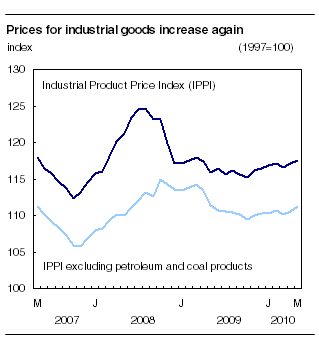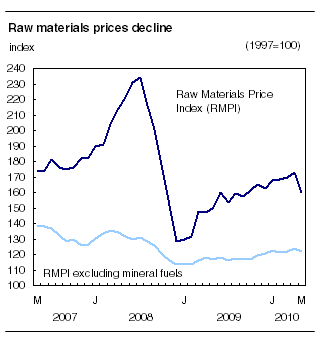Industrial Product Price Index for Canada up 0.3%
Tags: manufacturing
The Industrial Product Price Index (IPPI) for Canada increased 0.3 percent in May, mainly as a result of the weakening of the Canadian dollar against its American counterpart. The Raw Materials Price Index (RMPI) declined 7.2%, due primarily to lower crude oil prices. This is according to a report released June 29 by Statistics Canada.

The advance of the IPPI in May followed a 0.4% increase in April. The IPPI continued its upward trend that began in November 2009.
The 3.4% depreciation of the Canadian dollar relative to the US dollar had a large influence on the IPPI advance in May. Prices of motor vehicles and other transportation equipment, which are particularly influenced by the exchange rate, were up 2.3% in May, the largest monthly increase since October 2008 (+8.2%).
Pulp and paper products are also sensitive to exchange rate movements. Prices for this product group rose 2.7% in May, the largest monthly increase since October 2008 (+5.3%).
Some Canadian producers who export their products to the United States are generally paid on the basis of prices set in US dollars. Consequently, the relative weakness of the Canadian dollar in relation to the American dollar had the effect of increasing the corresponding prices in Canadian dollars. If the exchange rate used to convert those prices had remained unchanged, the IPPI would have declined 0.6% instead of increasing 0.3%.
To a lesser extent, chemicals and chemical products (+1.2%) as well as lumber and other wood products (+1.7%) contributed to the advance of the IPPI in May.
Note to readers
All data in this release is seasonally unadjusted and subject to revision for six months (for example, when the July index is released, the index for the preceding January becomes final).
The Industrial Product Price Index (IPPI) reflects the prices that producers in Canada receive as the goods leave the plant gate. It does not reflect what the consumer pays. Unlike the Consumer Price Index, the IPPI excludes indirect taxes and all the costs that occur between the time a good leaves the plant and the time the final user takes possession of it, including the transportation, wholesale, and retail costs.
Canadian producers export many goods. They often indicate their prices in foreign currencies, especially in US dollars, which are then converted into Canadian dollars. In particular, this is the case for motor vehicles, pulp, paper and wood products. Therefore, a rise or fall in the value of the Canadian dollar against its US counterpart affects the IPPI. But the conversion into Canadian dollars only reflects how respondents provide their prices. Moreover, this is not a measure that takes into account the full effect of exchange rates, since that is a more difficult analytical task.
The conversion of prices received in US dollars is based on the average monthly exchange rate (noon spot rate) established by the Bank of Canada, and it is available on CANSIM in table 176-0064 (series v37426). Monthly and annual variations in the exchange rate, as described in the text, are calculated according to the indirect quotation of the exchange rate (for example, CAN$1=US$X).
The Raw Materials Price Index (RMPI) reflects the prices paid by Canadian manufacturers for key raw materials. Many of those prices are set on the world market. However, most prices are denominated in Canadian dollars. For this reason, conversion into Canadian dollars has only a minor effect on the calculation of the RMPI. Moreover, the full effect of exchange rates on the RMPI is not measured, since that is a more difficult analytical task.
On the other hand, the IPPI increase in May was dampened mainly by lower prices of primary metal products (-2.9%) and petroleum and coal products (-2.3%), in part as a result of high inventories for these two product groups.
Excluding petroleum and coal prices, the IPPI would have increased 0.7% in May, the largest monthly increase since a 2.1% gain in October 2008.
12-month change: First increase in the IPPI since February 2009
The IPPI was up 1.4% in May compared with the same month a year earlier, marking its first year-over-year increase since an identical gain in February 2009.
The increase in the IPPI over the past 12 months was led mainly by petroleum and coal products (+16.6%) and primary metal products (+12.0%). Other product groups made smaller contributions to the advance of the IPPI, including chemicals and chemical products (+4.2%) and lumber and other wood products (+6.4%).
Since May 2009, the Canadian dollar has appreciated 10.7% in value relative to its US counterpart. If the direct effect of the exchange rate had been excluded, the IPPI would have increased 3.9% instead of 1.4%.
The year-over-year advance of the IPPI in May was moderated by lower prices of motor vehicles and other transportation equipment (-5.6%), which posted its smallest decrease since October 2009. The year-over-year decline of this product group in May was largely a result of the appreciation of the Canadian dollar relative to the US dollar.
Between May 2009 and May 2010, the IPPI excluding petroleum and coal was down 0.1%, smaller than the 2.6% decline in April and the smallest drop since June 2009.
Raw Materials Price Index: Most significant monthly drop since 2008
The Raw Materials Price Index posted a strong 7.2% decline in May, after four consecutive monthly increases. This was the largest monthly drop since a 15.3% reduction in December 2008. This change in direction for the RMPI in May was mainly due to a 12.7% fall in prices for mineral fuels, particularly crude oil (-14.2%).
A 6.1% drop in prices of non-ferrous metals in May also contributed to the decline of the RMPI, in part because of increased supply.
Prices of animal and animal products (+1.7%), ferrous materials (+1.5%) and wood products (+0.1%) increased in May, however, these increases had very little impact on the total RMPI.
Excluding mineral fuels, the RMPI would have decreased 1.5% in May, following gains of 0.4% in March and 2.0% in April.
From May 2009 to May 2010, raw materials prices rose 6.4%, the smallest year-over-year increase since November 2009, the month in which the current upward trend began. Crude oil prices (+10.2%) and non-ferrous metals (+16.4%) were the main contributors to the year-over-year RMPI advance in May. All groups posted increases except for vegetable products (-12.1%), non-metallic minerals (-0.6%) and wood products (-0.1%).

Available on CANSIM: tables 329-0038 to 329-0049 and 330-0006.
Tables 329-0040 to 329-0049: Industrial Product Price Index tables by commodity.
Table 329-0039: By total commodity aggregation and stage of processing.
Table 329-0038: By industry.
Table 330-0006: Raw Materials Price Index table by commodity.
Definitions, data sources and methods: survey numbers, including related surveys, 2306 and 2318.
The May 2010 issue of Industry Price Indexes (62-011-X, free) will soon be available.
The industrial product and raw material price indexes for June will be released on July 29.
For more information, or to enquire about the concepts, methods or data quality of this release, contact Client Services (toll-free 1-888-951-4550; 613-951-4550; fax: 613-951-3117; ppd-info-dpp@statcan.gc.ca), Producer Prices Division.
Table 1
| Relative importance1 | May 2009 | April 2010r | May 2010p | April to May 2010 | May 2009 to May 2010 | |
|---|---|---|---|---|---|---|
| (1997=100) | % change | |||||
| Industrial Product Price Index (IPPI) | 100.00 | 115.9 | 117.1 | 117.5 | 0.3 | 1.4 |
| IPPI excluding petroleum and coal products | 94.32 | 111.4 | 110.5 | 111.3 | 0.7 | -0.1 |
| Aggregation by commodities | ||||||
| Meat, fish and dairy products | 5.78 | 113.5 | 113.5 | 114.0 | 0.4 | 0.4 |
| Fruit, vegetables, feeds and other food products | 5.99 | 118.7 | 116.2 | 116.1 | -0.1 | -2.2 |
| Beverages | 1.57 | 129.9 | 131.5 | 131.6 | 0.1 | 1.3 |
| Tobacco and tobacco products | 0.63 | 223.6 | 222.7 | 222.8 | 0.0 | -0.4 |
| Rubber, leather and plastic fabricated products | 3.30 | 120.8 | 121.4 | 121.8 | 0.3 | 0.8 |
| Textile products | 1.58 | 102.2 | 101.5 | 101.7 | 0.2 | -0.5 |
| Knitted products and clothing | 1.51 | 104.7 | 105.3 | 105.3 | 0.0 | 0.6 |
| Lumber and other wood products | 6.30 | 80.2 | 83.9 | 85.3 | 1.7 | 6.4 |
| Furniture and fixtures | 1.59 | 124.7 | 124.7 | 124.7 | 0.0 | 0.0 |
| Pulp and paper products | 7.23 | 109.0 | 104.5 | 107.3 | 2.7 | -1.6 |
| Printing and publishing | 1.70 | 124.4 | 123.2 | 123.8 | 0.5 | -0.5 |
| Primary metal products | 7.80 | 122.7 | 141.5 | 137.4 | -2.9 | 12.0 |
| Metal fabricated products | 4.11 | 132.9 | 131.1 | 131.6 | 0.4 | -1.0 |
| Machinery and equipment | 5.48 | 111.6 | 107.3 | 108.1 | 0.7 | -3.1 |
| Motor vehicles and other transport equipment | 22.16 | 95.2 | 87.9 | 89.9 | 2.3 | -5.6 |
| Electrical and communications products | 5.77 | 95.4 | 91.0 | 92.1 | 1.2 | -3.5 |
| Non-metallic mineral products | 1.98 | 129.0 | 129.1 | 129.2 | 0.1 | 0.2 |
| Petroleum and coal products2 | 5.68 | 199.9 | 238.5 | 233.0 | -2.3 | 16.6 |
| Chemicals and chemical products | 7.07 | 132.4 | 136.4 | 138.0 | 1.2 | 4.2 |
| Miscellaneous manufactured products | 2.40 | 124.0 | 123.9 | 125.8 | 1.5 | 1.5 |
| Miscellaneous non-manufactured products | 0.38 | 268.4 | 213.0 | 216.5 | 1.6 | -19.3 |
| Intermediate goods3 | 60.14 | 118.2 | 122.0 | 122.2 | 0.2 | 3.4 |
| First-stage intermediate goods4 | 7.71 | 119.6 | 142.8 | 139.9 | -2.0 | 17.0 |
| Second-stage intermediate goods5 | 52.43 | 118.0 | 118.9 | 119.5 | 0.5 | 1.3 |
| Finished goods6 | 39.86 | 112.4 | 109.6 | 110.6 | 0.9 | -1.6 |
| Finished foods and feeds | 8.50 | 120.9 | 121.6 | 121.8 | 0.2 | 0.7 |
| Capital equipment | 11.73 | 104.0 | 97.9 | 99.3 | 1.4 | -4.5 |
| All other finished goods | 19.63 | 113.8 | 111.5 | 112.5 | 0.9 | -1.1 |